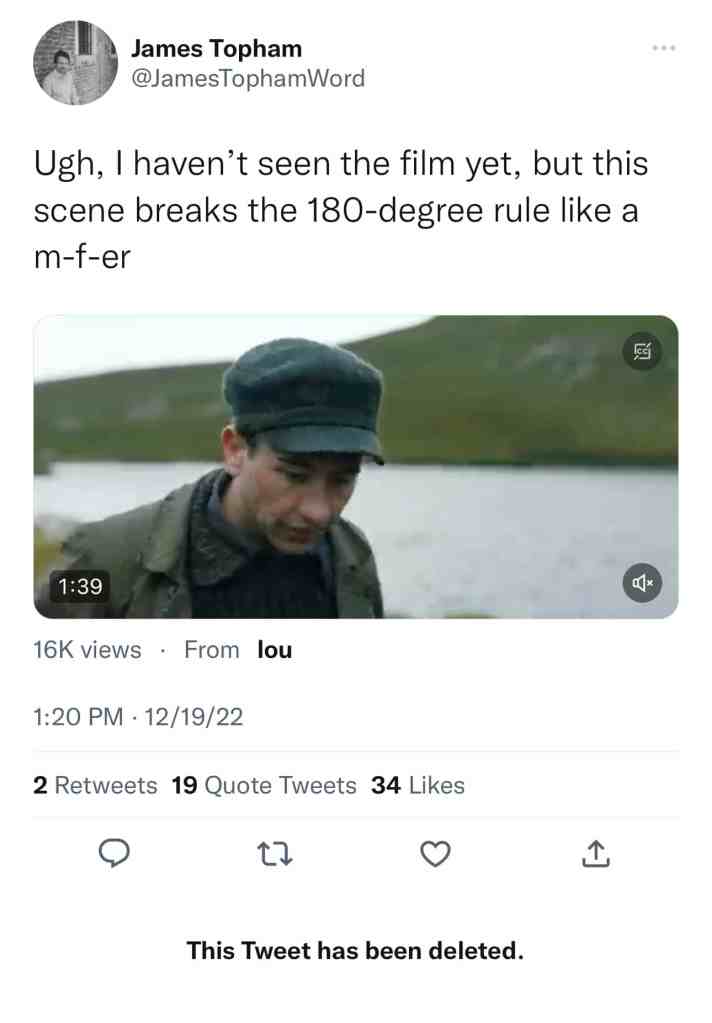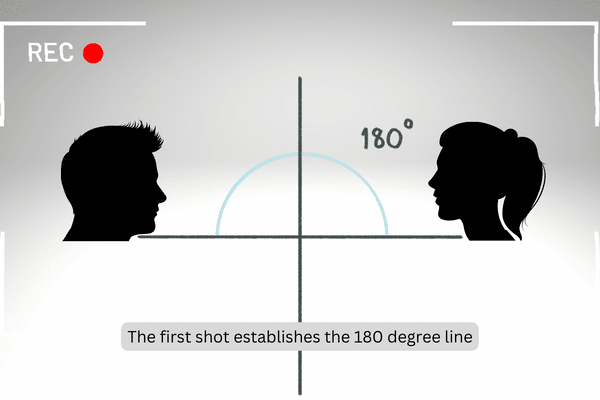If you’re as chronically online as I am, you’ve probably seen people from all corners of the world wide web recently weighing in on something known as the 180-degree rule. It’s something a lot of cinephiles hold sacred, in a similar way that painters may give reverence to the golden ratio. If you set a scene up with two people in front of the camera, the audience had better not see a shot from the opposite side that reveals the space in which the camera was previously located. Why? Well, simply put, it just feels odd.
I don’t know who first put into words that the 180-degree rule must never be broken – but it’s a filmmaking concept that’s been around for decades. So, why are people arguing about it on Twitter right now, in 2023?
The Banshees of Twitter
In a now-deleted Tweet, Twitter user James Topham (@JamesTophamWord) complained that a scene from new release The Banshees of Inisherin breaks the 180-degree rule. Here’s a screenshot of the post:

Here is the scene in question, so you may see for yourself how it plays out:
In case you’re wondering, James Topham is technically correct in his assertion: the scene does break the 180-degree rule. Where our opinions split is on whether it is ‘like a m-f-er’… OK, not really. But jesting aside, the bee in every Twitter user’s bonnet here regards his apparent need to disregard an entire film simply for the fact that one scene is composed of shots taken from all 360 degrees of the location.
Is it unconventional to break the 180-degree rule? Sure. Does it make a film bad? Not at all.
Read: Jean-Luc Godard: five filmmaking lessons from the French master
The 180 basics
Let’s revisit the rule: in cinema, the 180-degree rule refers to idea that the camera should be kept on one side of an imaginary axis between two characters, so that the first character is always frame right of the second character. Take this scene from Pulp Fiction (1994), which follows said rule to a T:
Here, Quentin Tarantino has established a spatial relationship between the characters in the scene, and maintains continuity in the shots. It orients the audience in the diner, and makes it clear where each character is in relation to the other.
Tarantino follows the rule by keeping the camera on one side of the axis for the duration of the sequence. When the camera changes position, it does so by crossing the axis to the other side, rather than breaking the axis and crossing back over to the original side. Thus we avoid confusion and maintain a sense of spatial continuity for the audience.
Let me break it down visually:




And cut
But! It’s important to note that the 180-degree rule is just a guideline and can be broken in certain cases, such as for artistic or stylistic reasons. Even though it’s widely considered a good practice to follow the rule in order to create a clear and coherent visual narrative, sometimes directors aren’t aiming to achieve that outcome.
Read: ScreenHub’s best advice for screen professionals in 2022
There are many directors who intentionally break the 180-degree rule (Kubrick, Aronofsky and Ozu to name but a few), to various effect. Mostly the break is employed to give the audience a feeling of disorientation, discomfort or confusion. Horror films and psychological thrillers are ripe for such experimentation, so why stick to the rules and settle for making your audience feel safe?
With all of this in mind, it may be worth re-examining that Banshees of Inisherin scene to see what director Martin McDonagh may have been trying to communicate with his choice of camera alignment.
The Banshees of Inisherin is in cinemas now





